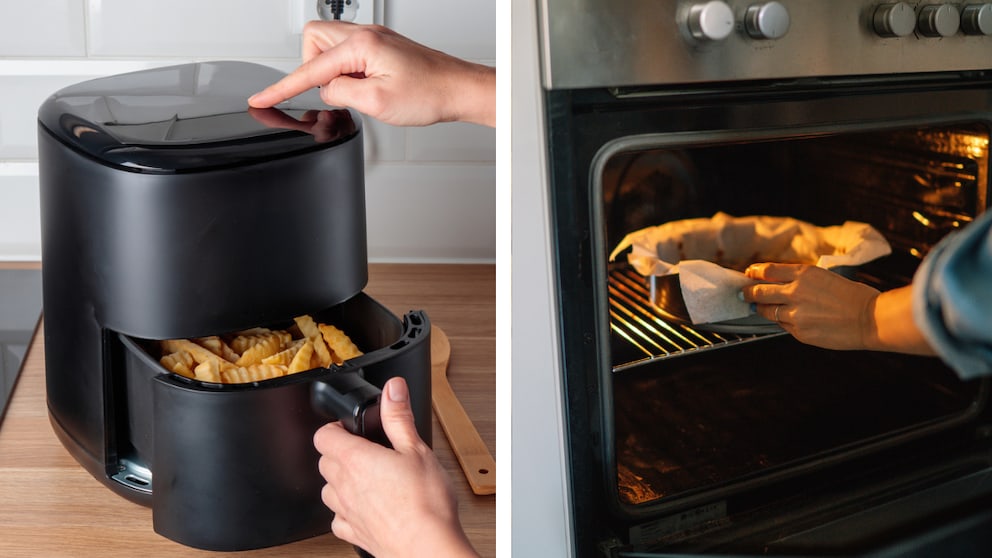March 7, 2025, 2:01 pm | Read time: 5 minutes
There is one kitchen appliance that you can hardly avoid at the moment: the air fryer. Its growing popularity is based in particular on the promise of crispy fried food — with little or no oil. An air fryer works with hot air, just like a classic oven. FITBOOK nutrition expert Sophie Brünke reveals whether a hot air fryer really offers decisive advantages.
Hot air fryers are in vogue. The statistics portal “Statista” predicts a steadily growing market volume for this kitchen appliance until 2030.1 In a world full of highly processed foods and high-calorie takeaway food, it seems tempting to enjoy crispy, deep-fried chips, nuggets, and the like in the kitchen at home, but with less fat. But do you really need a new kitchen appliance, or can a conventional oven give the air fryer a run for its money?
Overview
Air fryer — Less Fat Thanks to Hot Air?
First of all, air fryers are more like an oven than a classic deep fryer. This is because their function is based on the circulation of hot air; they are akin to “mini ovens with turbo convection.” And this “turbo” makes all the difference when you consider how much oil you need to add to the fried food. As an air fryer uses a powerful fan to blow the hot air around the fried food more intensively and in a more targeted manner than an oven, the result is an evenly crisp surface — even with little or no oil (a maximum of one to two tablespoons). In the oven, on the other hand, you need more oil. This difference is particularly noticeable with dishes such as fries or vegetable chips. Vegetables and meat, on the other hand, only need a little oil, even in the oven.
Which Method Is Gentler on Nutrients?
Some nutrients are particularly sensitive to heat, such as vitamin C. However, B vitamins and folic acid also benefit from not being heated for too long. The fat-soluble vitamins A, D, E, and K, on the other hand, are less affected by high temperatures.
It is estimated that half of the vitamin C content is lost within ten minutes at temperatures of 200 degrees Celsius. Here, the air fryer has a slight advantage, as it saves time during preparation, even though it still uses heat. While vegetables are ready to eat after around ten minutes in the air fryer, they take twice as long in the oven. Additionally, the air fryer eliminates the need for preheating, saving on electricity costs.
However, it should be emphasized that neither method falls into the “particularly vitamin-friendly” category. Especially for vegetables, preparation methods like steaming and stewing are more beneficial.
Harmful Acrylamide Is Always Produced During Browning Reactions
Are you already familiar with the term “acrylamide”? It is a harmful substance that is formed when starchy foods such as potatoes are browned by baking, frying, or roasting. The European Food Safety Authority (EFSA) classifies acrylamide as potentially carcinogenic to humans.2 Its formation is essentially dependent on the temperature — regardless of whether you use an air fryer or oven.
Acrylamide can be formed at temperatures as low as 120 degrees Celsius, with the acrylamide content rising sharply from around 170 to 180 degrees Celsius. In order to reduce absorption, care should be taken when frying or roasting to ensure that food is only golden brown in color and not dark or even black. The consumer advice center recommends setting the temperature to no more than 180 degrees Celsius when preparing potatoes and fries in convection ovens.3
Incidentally, a major advantage of the air fryer compared to the classic deep fryer is that this method produces up to 90 percent less acrylamide.4
The Air Fryer Is Ahead in Terms of Crispiness
As mentioned at the beginning, a powerful fan in the air fryer ensures fast and even heat distribution. As a result, the food is heated more efficiently from all sides and crisps more evenly than in the oven. However, the hot air fryer has one disadvantage: in order for this to work in practice, you cannot load the fryer basket as full as you like. As a rule, there are maximum markings from the manufacturers. This means that large portions or even quantities for the whole family cannot be fried in the appliance. For such tasks, the oven is the more suitable option. In both cases, shake or turn the food once halfway through the cooking time for extra crispiness.

Ideal for strength athletes 3 Protein-Rich Air Fryer Snacks

Expert Clarifies Granola Versus Muesli – Which is Healthier?

Nutrition tips from an expert 5 healthy snack recipes that keep blood sugar levels down
Conclusion
The air fryer offers several advantages over the oven: It requires less oil (therefore also saves calories), cooks food faster, and ensures a more even crispiness. In terms of nutrients, however, the differences are small. Although the air fryer is slightly ahead thanks to the shorter cooking time, methods such as steaming or stewing are still preferable for particularly vitamin-friendly preparation. Regarding acrylamide formation, the temperature plays a decisive role, regardless of the appliance. It is important that the food turns golden brown rather than black. If you need to prepare larger quantities at once, an oven is the preferred choice.

